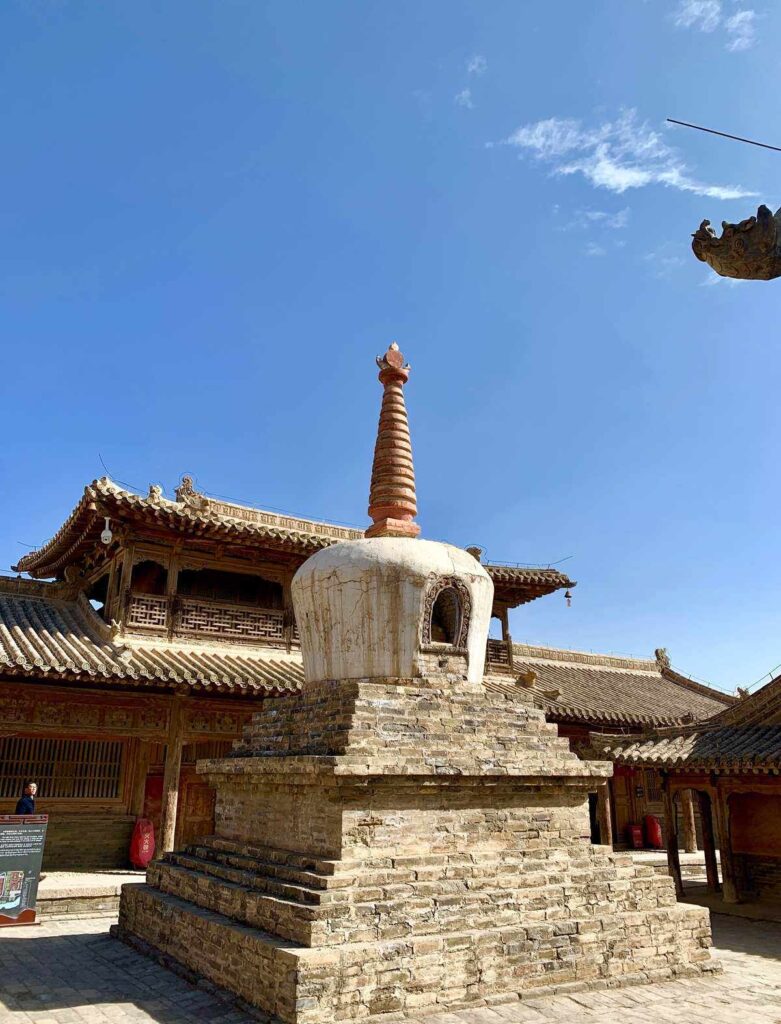
Drotsang Gon is a Geluk monastery in Tsongkha, Amdo, currently located in Ledu town or Drotsang in Tibetan. It was founded in 1392 by Samlo Lama Sanggye Tashi under his patron, the Ming Hongwu Emperor. It was built on the site of a Karma Kagyu monastery. It is famous for its symmetrical complex of temples in sino-Tibetan style. Sanggye Tashi was later invited to the new Ming Dynasty court in 1389, where he was granted the title of Imperial Preceptor by the Emperor. According to legend he traveled to Nanjing on a flying white elephant, earning the name Langkarpa Sanggye Tashi, or The White Elephant -riding Sanggye Tashi.” Upon his return to Drotsang, in 1392, Sanggye Tashi established a monastery, Drotsang Lhakhang Gautamde, designated by the Hongwu Emperor as Qutan Si, or Gautama Monastery, so written on a red board in golden letters that continues to hang above the entrance of the front hall. Apart from the Ming and Qing religious murals in the ambulatory, Drotsang monastery is one of the finest remaining examples of Ming palace architecture. Its architecture is similar to that of the Forbidden City in Beijing, and it is sometimes called ‘the little Gugong’. In common with many other Buddhist temples, it includes the following structures: Diamond Hall, Gautama Hall, Precious Light Hall, Hall of the Flourishing Nation, Bell Tower, Drum Tower and Stele Pavilion. However, it is best known for its exquisite murals, which not only enrich the main halls, but which also decorate the inner ambulatory that surrounds the temple’s inner courtyard. The murals in the surrounding ambulatory, which tell the stories of Buddha’s previous incarnations. There are ten plaques in the Ming and Qing Dynasties in Drotsang Temple. A bronze bell was cast in Xuande in the Ming Dynasty, three incense burners, cymbals, ivory beads, sandalwood beads, Milarepa Stone statues, gold seals given by the Ming and Qing emperors, cloisonne vases, ivory towers and many other precious cultural relics are kept in Drotsang temple. The temple also contains more than 300 Buddhist scriptures and works such as “Kanjur”, “Tanjur”, and “Je Tsongkhapa’s Anthology”, and nearly 100 relics from India were invited and enshrined in the stupa. The most striking of the extant relics in Drotsang Temple is the “Elephant Cloud Drum”.
Drotsang monastery has three high lamas, Draka Tsang, Drotsang Manpa Tsang and Drotsang Gupa Tsang. Among them, Draka Tsang is the main Lama of the Drotsang monastery. In fact, the reincarnation system of the Draka Tsang began in the year of Kangxi in the Qing Dynasty.
 Tibet World Travel Tibet Tour, Tibet Trip, Tibet Travel, Tibet Train, Tibet Trekking,
Tibet World Travel Tibet Tour, Tibet Trip, Tibet Travel, Tibet Train, Tibet Trekking,
